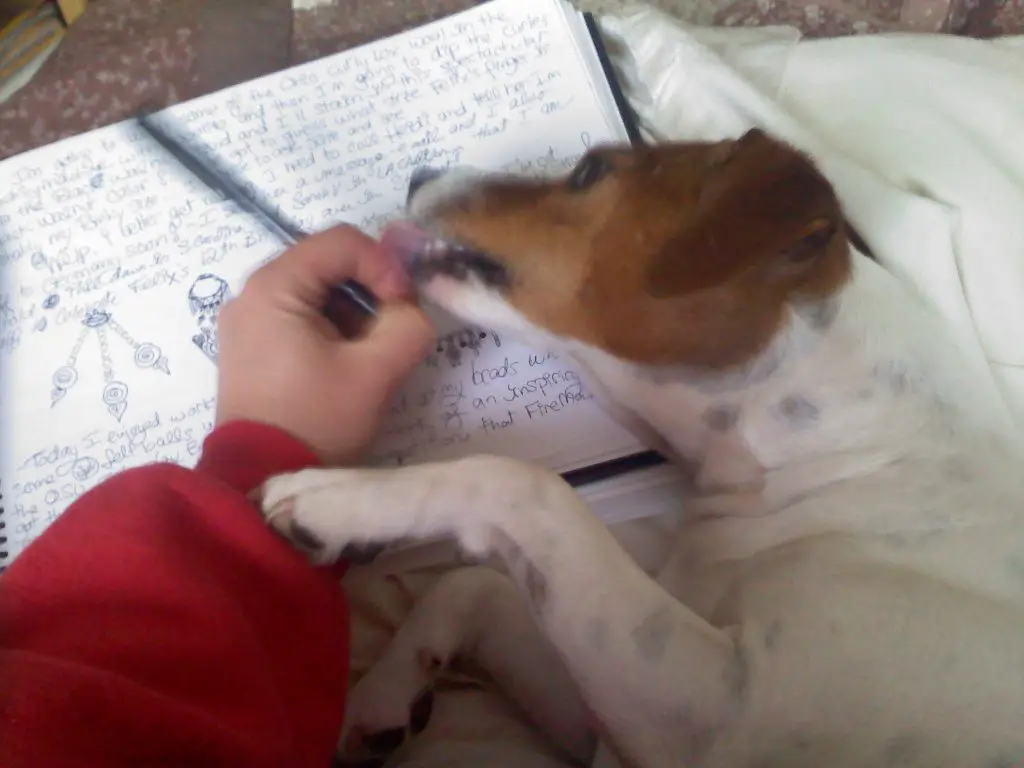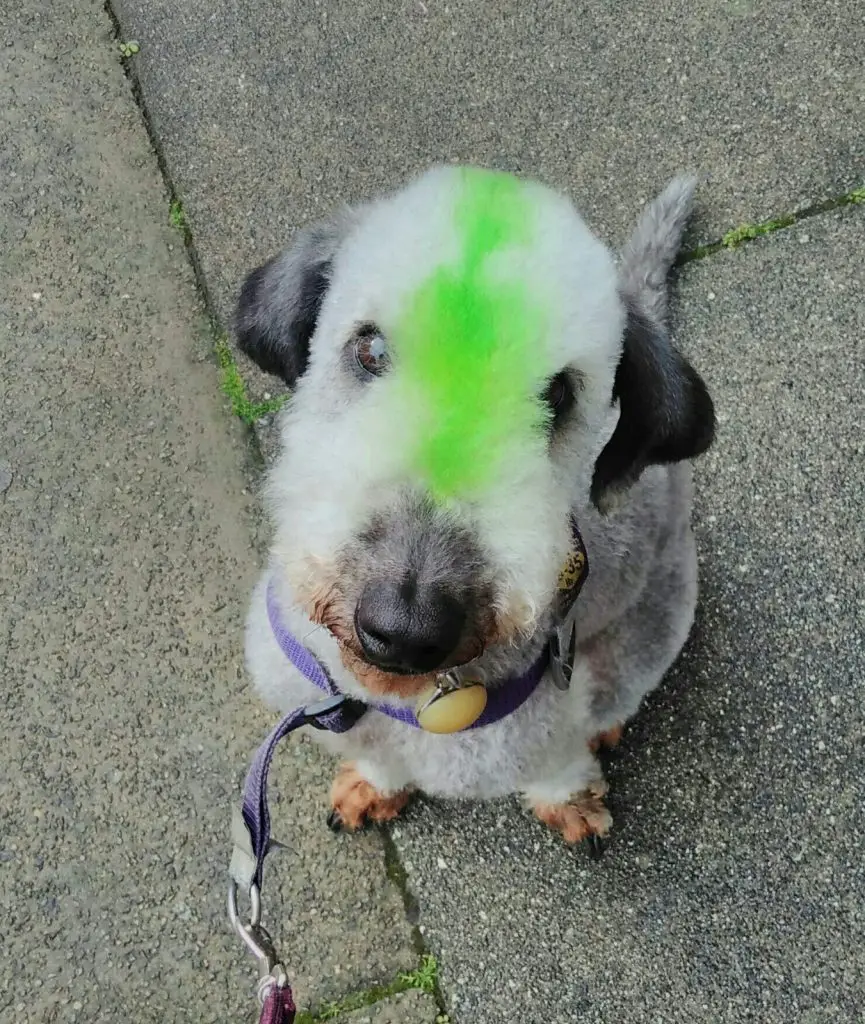Dogs are curious creatures and will often explore their environment with their mouths. This can sometimes lead to them ingesting things that they shouldn’t, including pen ink.
In this blog post, we will discuss the dangers of pen ink poisoning in dogs and what you can do to prevent it.
Key Takeaway
- Pen ink is generally not poisonous to dogs, as it’s made from non-toxic materials like water, pigments, and safe additives, and would need to be consumed in large quantities to be harmful.
- Symptoms of pen ink poisoning in dogs can include vomiting, diarrhea, lethargy, lack of appetite, non-responsive behavior, difficulty breathing, loss of consciousness, mouth irritation, constipation, restlessness, coughing, weakness, pale gums, and staggering.
- If your dog ate a pen, you should immediately contact your veterinarian or an emergency animal hospital for guidance as the physical parts of the pen can cause blockages or internal damage, even if the ink is generally non-toxic.
Is Pen Ink Poisonous To Dogs?

Pen ink is generally not considered poisonous to dogs, as most pens are made from non-toxic materials like water, pigments, and safe additives.
As a veterinarian, I’ve seen cases where dogs have chewed up pens and ingested some ink. Typically, the amount of ink in an ordinary ballpoint pen is unlikely to be toxic to a dog.
While they may end up with a temporarily stained tongue or mouth, serious complications are rare.
However, it’s important to keep in mind that while the ink itself might not be harmful, other parts of the pen can pose a risk.
The plastic casing, if swallowed, could potentially cause blockages in the digestive system. Also, although the amount of alcohol and glycol (or glycol ether) present in writing ink is usually small, these chemicals can be toxic to dogs in large quantities.
Therefore, if your dog has ingested a pen, it’s always a good idea to monitor them closely for any signs of distress such as vomiting, lack of appetite, or unusual behavior.
If you notice anything concerning, or if your dog has swallowed a significant portion of the pen, I would recommend seeking immediate veterinary attention.
What Are The Symptoms of Pen Ink Poisoning In Dogs?
The symptoms of pen ink poisoning in dogs can include gastrointestinal upset, vomiting, diarrhea, lethargy, lack of appetite, and difficulties in breathing.
Gastrointestinal Upset
In my years as a veterinarian, I’ve noticed that one of the most common symptoms after a dog ingests a pen is gastrointestinal upset. This can manifest as discomfort, bloating, or changes in bowel movements. The plastic from the pen, especially if chewed up and sharp, can potentially cause more severe issues such as GI obstruction.
Vomiting and Diarrhea
Vomiting and diarrhea are often clear signs that something is wrong with your pet. If your dog has ingested pen ink, they may vomit or have diarrhea due to the irritation caused by the ink or the pen’s plastic parts in their digestive system.
Lethargy and Lack of Appetite
Another symptom to watch out for is lethargy or an unusual lack of energy. Your dog might also show a lack of appetite. These symptoms can indicate that your dog is feeling unwell, possibly due to the ingestion of foreign materials like a pen.
Breathing Difficulties
In some cases, dogs may experience breathing difficulties after ingesting a pen. This could be due to the body’s response to a foreign object, or it could be a sign of a more serious problem like a blockage in the airways.
What Should I Do If My Dog Ate a Pen?

If your dog ate a pen, you should monitor them closely for any signs of distress and consult a veterinarian if necessary.
Observe Your Dog’s Behavior
As a veterinarian, I always advise pet owners to keep a close eye on their dog’s behavior after they’ve ingested something unusual.
Look out for signs of distress such as vomiting, loss of appetite, or abnormal behavior. These could be indications that the pen or its parts are causing harm internally.
Prevent Choking
Choking is another immediate concern when a dog swallows a foreign object like a pen. If your dog is choking, gagging, or struggling to breathe, it’s crucial to take them to a vet immediately.
There, professionals can safely remove the obstruction and provide necessary care.
Contact Your Vet
Even if your dog seems fine, it’s still a good idea to contact your vet and let them know what happened. They may want to examine your dog to ensure there’s no risk of internal blockages or other complications.
In my practice, I’ve seen cases where symptoms don’t appear immediately, so it’s always better to be safe than sorry.
Keep Dangerous Items Out of Reach
Finally, use this incident as a reminder to keep potentially harmful items out of your dog’s reach. Dogs are naturally curious and often explore their world through their mouths, so it’s our responsibility as pet owners to ensure their environment is safe.
After treating many dogs who’ve eaten things they shouldn’t have, I cannot stress enough the importance of prevention in these situations.
How Do You Get Ink Off a Dog?

To get ink off a dog, use a pet-safe shampoo and warm water, gently scrubbing the stained area until the ink is removed.
When I’ve dealt with this situation in my veterinary practice, here’s the approach I’ve found most effective. First, you need to wet the stained area with warm water, taking care not to get any in your dog’s eyes, ears, or mouth.
Then, apply a pet-safe shampoo directly to the stain. Using a soft cloth or sponge, gently scrub the area until the ink starts to lift. It may take a few wash-rinse cycles to completely remove the ink, so be patient.
Remember, some ink stains can be stubborn, especially if they’ve had time to set. If you’re struggling to remove the stain, don’t resort to using harsh chemicals or human products as these can be harmful to your dog’s skin. Instead, consult with a professional groomer or your vet for advice.
After the stain is removed, rinse your dog thoroughly to ensure no shampoo residue remains. Then, dry them off with a towel to prevent them from getting cold. Always remember to praise your dog and perhaps give them a treat for their patience during this process.
Over the years, I’ve found that a little positive reinforcement goes a long way in making potentially stressful situations like this more tolerable for our furry friends says PetKeen.
FAQs
Q: Can pen ink poisoning in dogs be fatal?
A: In severe cases or if the ingestion is not treated promptly, pen ink poisoning can potentially be fatal for dogs. It is crucial to seek veterinary care as soon as possible.
Q: How can I prevent my dog from getting into pen ink?
A: To prevent your dog from accessing pen ink, make sure to store pens and other ink-containing items in a secure location that is out of your dog’s reach. Additionally, avoid leaving pens or ink cartridges lying around where your dog can easily access them.
Q: Are there safe alternatives to pen ink for dogs to use?
A: There are pet-safe inks available on the market that are specifically formulated for use with dogs. These inks are non-toxic and can be used for various purposes, such as paw prints or creating artwork.
Q: Can dogs safely play with pens that don’t contain ink?
A: While playing with pens that don’t contain ink may not pose a direct poisoning risk, there is still a chance that a dog could accidentally swallow a small part of the pen, which could lead to choking or intestinal blockage. It is best to provide your dog with safe, dog-specific toys instead.
Q: What should I do if my dog has already ingested pen ink and there are no immediate veterinary options available?
A: If urgent veterinary care is not immediately available, you can contact a pet poison control hotline for guidance. They can provide you with important instructions on how to manage the situation until you can seek professional help.
Q: Can pen ink poisoning affect other pets, such as cats?
A: Yes, pen ink poisoning can affect other pets as well, including cats. It is important to be cautious and keep all pets away from potential hazards, such as pen ink.
Q: Can humans also be affected by pen ink poisoning?
A: While pen ink is not typically considered toxic to humans, it is still important to avoid ingesting large amounts of ink or getting it on your skin or in your eyes. If you experience any concerning symptoms after contact with pen ink, it is recommended to seek medical advice.
Conclusion and final thoughts
In conclusion, while pen ink may not necessarily be considered toxic to dogs, it is important for pet owners to take precautionary measures when it comes to their furry friends’ exposure to this substance.
Ink can cause potential gastrointestinal irritation or blockages if ingested in large quantities by a dog. Additionally, the chemicals and solvents found in some types of inks can be harmful to dogs if they come into contact with their skin or are inhaled.




